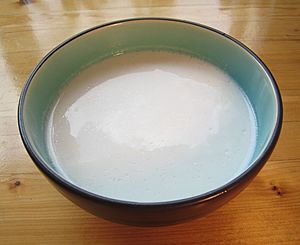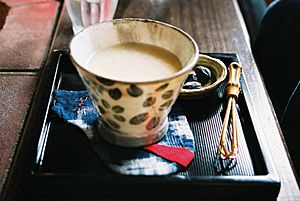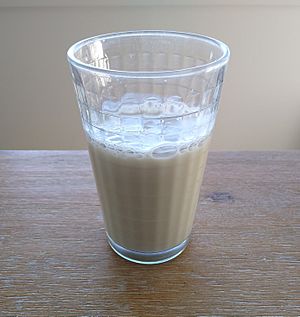Plant milk facts for kids

|
|
| Type | Non-dairy beverage and ingredient |
|---|---|
| Color | White |
| Flavor | Various; creamy texture |
| Ingredients | Water and a grain, pseudocereal, legume, nut, seed, or coconut |
Plant milk is a drink made from plants that looks a lot like regular milk. These drinks are made by mixing water with parts of plants. They are often used instead of animal milk. Plant milks usually have a creamy feel in your mouth. Some of the most popular types around the world are almond, oat, soy, and coconut milk.
Making plant-based milks, especially soy and oat milks, can be better for the environment. They often use less land, water, and create fewer greenhouse gases than animal milks.
People have been drinking plant-based beverages for hundreds of years. The term "milk-like plant juices" was used as early as the 1200s. Today, these drinks are often called plant-based milk, alternative milk, non-dairy milk, or vegan milk. When sold in stores, they usually come in containers that look like those for dairy milk. However, in some places like the European Union, they cannot be officially called "milk."
Plant milk is used in many cultures as a drink and in cooking. For example, coconut milk is a key ingredient in many curries. These milks fit well with vegetarian and vegan diets. Plant milks are also used to make things like ice cream, plant cream, vegan cheese, and yogurt-like products, such as soy yogurt. In 2021, experts thought the global plant milk market could be worth about US$62 billion by 2030.
Contents
History of Plant Milks
Before plant milks were made in factories, people created similar drinks for centuries. For instance, the Wabanaki and other Native American groups in the northeastern United States made milk from nuts. They even used it for baby formula.
Horchata, a drink from North Africa, was first made from soaked, ground, and sweetened tiger nuts. It came to Spain before the year 1000. In English, the word "milk" has been used for "milk-like plant juices" since about 1200 CE.
Recipes from the 1200s in the Middle East describe how to make almond milk. In China, soy milk was used in the 14th century. During Medieval England, almond milk was used in dishes like ris alkere, a type of rice pudding. You can find it in an old recipe book called The Forme of Cury. Coconut milk is also a traditional ingredient in many foods, especially in South and Southeast Asia, where it's often used in curries.
In Western countries, plant milks are often seen as a milk substitute. However, in other parts of the world, they have been common drinks for a long time. This is especially true in places where many people have lactose intolerance, which means they can't digest regular milk easily.
Different Types of Plant Milks
Some common plant milks you might know are almond milk, coconut milk, rice milk, and soy milk. Other types include hemp milk, oat milk, pea milk, and peanut milk.
Plant milks can be made from many different sources:
- Grains: barley, oat, rice, rye, sorghum, wheat, and more.
- Pseudocereals: Plants like amaranth, buckwheat, and quinoa.
- Legumes: Such as lupin, pea, peanut, and soy.
- Nuts: Including almond, brazil, cashew, hazelnut, macadamia, pecan, pistachio, and walnut.
- Seeds: Like chia seed, flax seed, hemp seed, pumpkin seed, sesame seed, and sunflower seed.
- Other: This includes coconut (which is a fruit), potato (a root vegetable), and tiger nut (also a root vegetable).
A blend is a plant milk made by mixing two or more types together. For example, you might find almond-coconut milk or almond-cashew milk.
Some traditional plant milk recipes from around the world include:
- Kunu: A Nigerian drink made from sprouted millet, sorghum, or maize.
- Sikhye: A sweet Korean rice drink.
- Amazake: A Japanese rice milk.
How Plant Milks are Made
| Milk Types | Greenhouse Gas Emissions (kg CO2-Ceq per 200 g) |
|---|---|
| Cow's milk |
0.62
|
| Rice milk |
0.23
|
| Soy milk |
0.21
|
| Oat milk |
0.19
|
| Almond milk |
0.16
|
| Milk Types | Water use (L per 200 g) |
|---|---|
| Cow's milk |
131
|
| Almond milk |
74
|
| Rice milk |
56
|
| Oat milk |
9
|
| Soy milk |
2
|
| Milk Types | Land Use (m2 per 200 g) |
|---|---|
| Cow's milk |
1.81
|
| Oat milk |
0.25
|
| Soy milk |
0.23
|
| Almond milk |
0.19
|
| Rice milk |
0.14
|
The way plant milks are made can be different depending on the plant used. But here's a general idea of how soy milk is made:
- First, the beans are cleaned, soaked, and their outer skins (husks) are removed.
- Next, the beans are ground into a thick liquid, powder, or smooth mixture.
- Then, the plant material is heated. This helps to improve the flavor.
- After heating, any solid bits are filtered out.
- Water, sugar (or sugar substitutes), and other ingredients are added. These help improve the taste, smell, and add important nutrients.
- The liquid is then pasteurized, which means it's heated to kill germs.
- It's also homogenized. This breaks down tiny fat drops and particles to make the drink smooth.
- Finally, the plant milk is packaged, labeled, and stored.
In many store-bought plant milks, the actual amount of the main plant (like almond or oat) might be around 2%. Other things often added during making include guar gum or xanthan gum. These are ingredients that help make the texture and feel of the drink better. Important nutrients like calcium, B vitamins, and vitamin D are often added too. Salt and natural or artificial flavors are also included for taste and smell.
Making plant-based milks, especially soy and oat milks, can be better for the environment. They often use less land, water, and create fewer greenhouse gases than animal milks. However, making almond milk has been criticized because it uses a lot of water and pesticides.
Comparing Plant Milk and Cow's Milk
Many plant milks are made to have similar proteins, vitamins, and fats as milk from animals. Generally, because plant milks are made from processed plant parts, they don't naturally have as many nutrients as dairy milk. So, during manufacturing, they are often fortified. This means specific amounts of micronutrients, like calcium and Vitamins A and D, are added. Animal milks are also often fortified, and in many countries, laws require certain nutrients to be added to milk products.
Nutritional content of human, cow, soy, almond, and oat milks
Non-human milks are fortified
| Nutrient value per 250 mL cup |
Human milk |
Cow milk (whole) |
Soy milk (unsweetened) |
Almond milk (unsweetened) |
Oat milk (unsweetened) |
|---|---|---|---|---|---|
| Energy, kJ (cal) | 172 (720) | 149 (620) | 80 (330) | 39 (160) | 120 (500) |
| Protein (g) | 2.5 | 7.69 | 6.95 | 1.55 | 3 |
| Fat (g) | 10.8 | 7.93 | 3.91 | 2.88 | 5 |
| Saturated fat (g) | 4.9 | 4.55 | 0.5 | 0.21 | 0.5 |
| Carbohydrate (g) | 17.0 | 11.71 | 4.23 | 1.52 | 16 |
| Fiber (g) | 0 | 0 | 1.2 | 0 | 2 |
| Sugars (g) | 17.0 | 12.32 | 1 | 0 | 7 |
| Calcium (mg) | 79 | 276 | 301 | 516 | 350 |
| Potassium (mg) | 125 | 322 | 292 | 176 | 389 |
| Sodium (mg) | 42 | 105 | 90 | 186 | 101 |
| Vitamin B12 (mcg) | 0.1 | 1.10 | 2.70 | 0 | 1.2 |
| Vitamin A (IU) | 522 | 395 | 503 | 372 | - |
| Vitamin D (IU) | 9.8 | 124 | 119 | 110 | - |
| Cholesterol (mg) | 34.4 | 24 | 0 | 0 | 0 |
Selling and Buying Plant Milks

Plant-based milks have become popular as an alternative to dairy milk. This is because people are making different food choices and changing their views on animals and the environment. Many people now regularly buy non-dairy milk options for health and environmental reasons. For example, in the United Kingdom, fewer young people (aged 16-24) drink dairy milk now compared to 1974.
To compete better, plant milks are usually sold in containers that look like dairy milk cartons. Some plant milk companies suggest that plant milks are "good and wholesome," while dairy milk might be "bad for the environment." More young people are connecting dairy farming with environmental harm. There are also concerns that dairy farming affects biodiversity, water use, and land use. Videos like 'Cowspiracy' and 'What the Health' have also shared these negative ideas about dairy farming. Concerns about animal welfare have also made dairy milk less popular in many Western countries.
Advertising for plant milks often compares the hard work of dairy farming to the easier way plants like oats, rice, or soybeans are grown. For example, the oat milk brand Oatly even had an advertisement during the Super Bowl in 2021.
In the United States, sales of plant milk grew a lot, by 61% between 2012 and 2018. By 2019, the plant-based milk industry in the USA was worth $1.8 billion each year. In 2018, "dairy alternatives" around the world were worth $8 billion. Among plant milks in the US in 2018, almond milk was the most popular (64% of sales), followed by soy (13%) and coconut (12%). Oat milk sales grew very quickly in Canada in 2019. Its growing popularity in the United States and United Kingdom even caused shortages because so many people wanted it. In 2020, Starbucks started offering oat, coconut, and almond milk in its stores in the US and Canada. By 2020, oat milk sales in the US reached $213 million, making it the second most popular plant milk after almond milk.
One main reason for the rise in popularity of plant-based milks, like pea milks, is lactose intolerance. This is when people have trouble digesting lactose, a sugar found in milk. For example, in Australia, about 4.5% of people are lactose intolerant. In the United States, around 40 million people have lactose intolerance.
Names and Rules for Plant Milks
Plant milks can be labeled to show what nutrients they contain. They might also use terms like "dairy-free," "gluten-free," or "GMO-free" to describe what's in them or what's not.
Companies that make and sell animal milk have asked that plant-based milks not be called "milk." They worry that buyers might get confused. They also say that plant-based milks might not have the same amount of vitamins and minerals as dairy milk.
Rules in Europe
In December 2013, rules in the European Union said that words like "milk," "butter," "cheese," "cream," and "yogurt" can only be used for products made from animal milk. There are a few exceptions, like coconut milk, peanut butter, and ice cream. In 2017, a German court asked the Court of Justice of the European Union to explain these rules. The court said that plant-based products cannot be sold as milk, cream, butter, cheese, or yogurt in the European Union. This is because these words are saved for animal products. Tofu and soy are not exceptions to this rule. Even though plant-based dairy alternatives can't be called "milk," they can be described as "buttery" or "creamy."
In the United Kingdom, there are strict rules for food labels. Words like milk, cheese, cream, and yogurt are protected. They can only be used to describe dairy products. However, there are some exceptions in each EU language. These exceptions are based on how long certain terms have been used for non-animal products. For example, there's only one exception in Polish, but 20 exceptions in English.
In May 2021, a plan to add more rules was not approved by the European Parliament. This plan would have stopped labels like 'yogurt-style' and 'cheese alternative'.
Rules in the United States
In the United States, the dairy industry asked the FDA to ban words like "milk," "cheese," "cream," and "butter" on plant-based products (except for peanut butter). In 2018, FDA commissioner Scott Gottlieb said that the word "milk" was used incorrectly for non-dairy drinks like soy, oat, and almond milk. He said, "An almond doesn't lactate" (meaning it doesn't produce milk). In 2019, the US National Milk Producers Federation asked the FDA to limit how plant-based milks are labeled. They said these products should be called "imitation."
However, the Plant-Based Foods Association said that "imitation" was a bad word. They also said there was no proof that people were confused about plant-based milks. A 2018 survey found that people in the United States usually don't confuse plant-based drinks with animal milk or dairy products. As of 2021, courts have decided that regular buyers are not confused. The FDA has not made any rules against plant-based milk labels.
In 2021, the FDA made a final rule about what "yogurt" means (it still has to be made from "milk-derived ingredients"). The FDA is also planning to give advice on "Labeling of Plant-based Milk Alternatives" in 2022.
People who support plant-based milk say these labeling rules treat buyers like children. They also say the rules are unfair to dairy alternatives. Critics of the FDA's rules also point out that government officials and the dairy industry sometimes work together. They try to keep dairy milk as the main product in the market. For example, in 2017, Senator Tammy Baldwin suggested a law called the "DAIRY PRIDE Act." This law would stop almond milk, coconut milk, and cashew milk from being called milk, yogurt, or cheese.
Supporters of plant-based dairy alternatives say that dairy sales are going down faster than plant milk sales are going up. So, they argue that plant milks are not the main reason for less dairy milk being bought. A 2020 study found that the increase in sales of plant-based options from 2013 to 2017 was much smaller than the decrease in how much cow's milk Americans bought.
Images for kids
See also
 In Spanish: Leche vegetal para niños
In Spanish: Leche vegetal para niños









